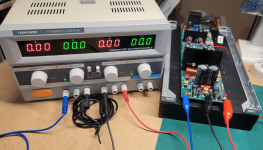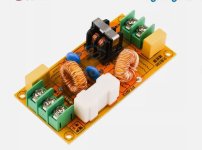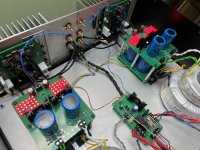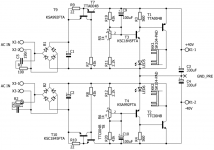Hi OS,
Many thanks! I'll grab the manuals for those and have another look. I've worked on pretty much every one. Under warranty you're only concerned with why it failed and repairing it properly. It's very interesting coming back around from the future and remembering working on them.
Hi danieljw,
Thanks, yes. Almost 50 years and I even figured out which end of the soldering iron you're supposed to hold! lol!
Your point on shipping weight is bang on. This determined much design change through the 1980's and later. Also, going from a chassis design to more unit body. That makes everything harder to work on. They shifted manufacturing costs onto the consumer when service time rolls around. In other words, the accountants became instrumental on product design.
Many thanks! I'll grab the manuals for those and have another look. I've worked on pretty much every one. Under warranty you're only concerned with why it failed and repairing it properly. It's very interesting coming back around from the future and remembering working on them.
Hi danieljw,
Thanks, yes. Almost 50 years and I even figured out which end of the soldering iron you're supposed to hold! lol!
Your point on shipping weight is bang on. This determined much design change through the 1980's and later. Also, going from a chassis design to more unit body. That makes everything harder to work on. They shifted manufacturing costs onto the consumer when service time rolls around. In other words, the accountants became instrumental on product design.
Lighten up! Good gracious, you seem to be the grumpy sort. I've already admitted that I was hasty in my reply, and made the correction, and acknowledged that continuing the discussion may not add further value. YOU seem to have some axe to grind.And even now you still don't understand why that message of you was so wrong. RTFM you said. Yes let's just do that, practice what you preach. Read The ******* Manual. I give you a pointer to the most relevant part below.
Note that on this unit the master is at RHS as pointed out in the manual page 2 - 4.
View attachment 1358678
Do you agree if the switches are in the position depicted in the photo in #4471 AND if it's wired the way you show, that it would not be correct? The person needing help asked for a SERIES orientation. You did show wiring for the independent supplies which, once again, I admit that I missed when I first read your post.
Chill.
"Party speakers" are best with a 5-6.5" ferrofluid mid and a piezo supertweeter for 5K+. I've fried OEM (polk) tweeters , they are so muchI think OS had in mind that the full potential of Wolverine would require such speakers and most importantly human temptation fueled by alcohol at some good party would turn up the volume a little bit and a bit more leading to speaker disaster. I saw and heard it.
junk. Even a Dayton (ferrofluid) soft dome is a major step up.
Splitting things up is helpful to your speakers , monitor your satellites to avoid any clipping. I can't blow my sub - uPC400 + my 12" is a perfect match.
It was not the wolverines fault blowing a polk tweeter , polk tweeters are 3$ junk with a 2oz. magnet.
My wolverine clips at 110V p-p (200W) , my other "party" amp , (Sonance) can do the same 200W-4R (80V pp)
Wolverine with 4R can do 300+W peaks , lots of "grunt"! All my AB amps use Sanken A1386/C3519 (HK680/Sonance260/Wolverine).
Bought 40 devices for <50$ (on eBay). ALL the OEM's show those Sankens optimal 50-60mA bias. Amp's run very cool.
Sanken A1386/C3519 are even in old 80's amps and they are still a active product line !
OS
The way I wired it is suitable for both Independent AND Serial. So no, I do not agree with your nonsense.Do you agree if the switches are in the position depicted in the photo in #4471 AND if it's wired the way you show, that it would not be correct? The person needing help asked for a SERIES orientation. You did show wiring for the independent supplies which, once again, I admit that I missed when I first read your post.
Let me know if you wanna bet on it, I have a nice stake in mind.
Last edited:
^ I think I follow... but no, I don't want to bet on it, I'm here to learn. I'll review the manual one more time... I am clearly missing something critical. I will, however happily supply a beverage of choice for helping a novice like me learn. Back to the books.

OmeEd. You are extremely argumentative without cause. Keep your posts technical and not personal. We expect a professional demeanor here.
ItsAllInMyHead's posts were fine, he was unsure and made an error, again fine. At no point did he argue this. You picked a fight over nothing here. If you don't agree, that's okay but it does not give you cause for a personal attack.
Please adjust your posting style.

Can I ask what function does this board provide? see attached photo.Final testing, everything is looking good so far. I cannot hear any noise even with my ear right next to the speaker.
Big thanks to the wolverine team for their hard work creating this wonderful amp.
thanks
Finally got the right cables to wire this up for initial testing. The supply is set for series.I don't have Photoshop at hand on this PC, hope the draft drawing is sufficient. Notice the markings at the PCB terminals too.
With this wiring, setting the supply at independent should work.
Usually it also works in series mode, but I have no experience with this particular model.
Parallel will not work.
Notice ground on the PSU is not necessary the same same as ground on amp, here it's not.
Check everything with DMM before connecting.
View attachment 1358359
Attachments
That should work just fine.
Make sure current limits are set the same, limit set for a bit above your expected bias current, like 20% or more. That is to limit damage due to a malfunction and give you a chance to get the bias current set properly. Once it is running in a stable way, you can increase current limits and connect a load to test at low power (1 watt is industry standard). Don't expect proper performance at lower supply voltages than it is designed to run at. 30 V may not be enough to allow normal operation delivering some current.
Keep in mind, my comments are general ones for all amplifiers. I haven't built this one, or seen one for test.
Make sure current limits are set the same, limit set for a bit above your expected bias current, like 20% or more. That is to limit damage due to a malfunction and give you a chance to get the bias current set properly. Once it is running in a stable way, you can increase current limits and connect a load to test at low power (1 watt is industry standard). Don't expect proper performance at lower supply voltages than it is designed to run at. 30 V may not be enough to allow normal operation delivering some current.
Keep in mind, my comments are general ones for all amplifiers. I haven't built this one, or seen one for test.
I've seen wolverine (4 output 71V SMPS) do 800W/2R while testing an output current limit for speaker protection."Party speakers" are best with a 5-6.5" ferrofluid mid and a piezo supertweeter for 5K+. I've fried OEM (polk) tweeters , they are so much
junk. Even a Dayton (ferrofluid) soft dome is a major step up.
Splitting things up is helpful to your speakers , monitor your satellites to avoid any clipping. I can't blow my sub - uPC400 + my 12" is a perfect match.
It was not the wolverines fault blowing a polk tweeter , polk tweeters are 3$ junk with a 2oz. magnet.
My wolverine clips at 110V p-p (200W) , my other "party" amp , (Sonance) can do the same 200W-4R (80V pp)
Wolverine with 4R can do 300+W peaks , lots of "grunt"! All my AB amps use Sanken A1386/C3519 (HK680/Sonance260/Wolverine).
Bought 40 devices for <50$ (on eBay). ALL the OEM's show those Sankens optimal 50-60mA bias. Amp's run very cool.
Sanken A1386/C3519 are even in old 80's amps and they are still a active product line !
OS
I'm not saying it should, but it can. This was only on a scope, no doubt distortion would have been 1-10%.
You must have a big one (amp-PS). My Wolverine must be about the smallest with it's 500VA trafo and little Sanken MT-100's.I've seen wolverine (4 output 71V SMPS) do 800W/2R while testing an output current limit for speaker protection.
Only +/- 54V rails. Someone had a used Antek trafo on eBay. Just 35$ , same seller had a dozen 10Kuf/63V panasonics , as well.
I have not used any SMPS's. In fact , I filter (below) my high-fi , gotta fight that horrible SMPS "hash" - ALL toroids for me.
Bad enough I have the horrible PC SMPS's on my systems. I even link to my amps optically. NO electrical connections between
digital and analog.
I have a good DAC , but the 15V supply for it shows as 50mV of nasty spikes. Got to build myself a nice linear regulator to power
it. What is the use of selling a -115db/.0005% DAC just to include a 5$ cheap China SMPS to power it ??
OS
Attachments
Very true OS.
SMPS is a module they buy (= job done), it is cheaper to ship and cheaper to buy.
The average person doesn't consider these things and may never notice, so they sell it.
Hi sajti,
Shunt isn't the only way to get to a clean supply. Dissipating power is always a bad thing as well.
SMPS is a module they buy (= job done), it is cheaper to ship and cheaper to buy.
The average person doesn't consider these things and may never notice, so they sell it.
Hi sajti,
Shunt isn't the only way to get to a clean supply. Dissipating power is always a bad thing as well.
Shunt regulator is fine for preamplifiers, for <100mA. In my case the dissipation is approx. 2W/channel...
I find a combination of shunt and pass works the best. Like the best of both worlds. It's also a great way to isolate sections from each other.
I'm going to start with a simple LM317 (pass) , I'm actually running my DAC from the +/- 12V supply of my amp now , much quieter.I find a combination of shunt and pass works the best. Like the best of both worlds. It's also a great way to isolate sections from each other.
As far as isolation , I am listening to SPDIF optical now. Never USB (and that dirty PC ground).
I'll look for a reasonable shunt to run after a 317.
How would you do that ? Pass regulate to one voltage (317) , then shunt away a few more volts to get to the target ?
Edit - ??? https://tangentsoft.com/elec/opamp-linreg.html
OS
Last edited:
- Home
- Amplifiers
- Solid State
- DIY Class A/B Amp The "Wolverine" build thread



